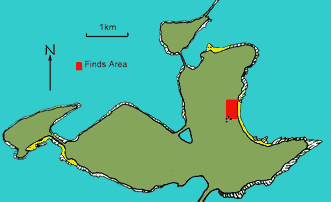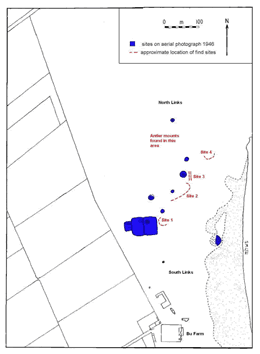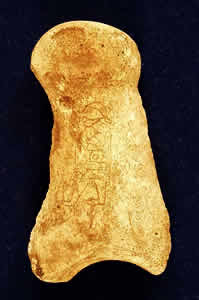


|
A New Pictish Figure from Orkney |
|||||||||||
Bu Sands is an area of fixed sand dunes in a bay lying on the east coast of Burray (see figure 1). The name Bu typically indicates a site of importance and the B-listed Bu Farm has been an important site historically, an earlier building being home to a branch of the Stewart family. The North Links are the most important source of high quality building sand in Orkney and are used recreationally as a motorcross track but have been proposed as an area of local nature conservation importance for ornithology in the Orkney Islands Council Development Plan (2003). This area was not examined in the archaeological survey of Orkney's coasts by EASE (Moore and Wilson 1997).
Sand extraction works and blow-out subsequent to motorcross activity led to the exposure of archaeological remains at Bu Sands between 1987 and 1990 (Smith et al 1988). Surface finds were collected from the area on a number of occasions, with four site locations noted by Beverley Ballin Smith around OS grid reference ND 476975. These finds include iron age pottery, stone tools and iron-smelting debris, but are predominantly animal bones. Many of these finds have been deposited with the Orkney Museum in Kirkwall. The most notable items published hitherto are four decorated antler mounts and a stone "egg amulet" (Hunter 1993). In 1993, reports of human remains becoming exposed led to Daphne Home Lorimer making a visit to the site together with Bill Cormack and Margaret Watters. The presence of at least four human burials was confirmed and a small number of finds collected. Further midden deposits were reported as exposed in July 1996. No controlled excavation of the site has been undertaken however and there have been no additional reports of finds, nor any further evidence of archaeological material remaining in situ.
Examination of aerial photographs taken by the RAF during the 1946 and in the 1950s, which show the find area and are in the possession of Orkney Archaeological Trust, has indicated the existence of a number of circular features - earthworks and parchmarks - at that time. These features were graphically located (Kilford 1975) on the Ordnance Survey grid, based on points which could be identified both on the photographs and on the 1:2500 Ordnance Survey map of the region. This method is liable to cumulative errors and no attempt was made to interpret feature height or relief. It was felt that this method was suitable for the scale of the plans and uncertain location of the finds. No record was found of any military installations in the area nor of any other previously known archaeological structures that would explain the observed features. The results of this process were compared with the locational notes made by Smith: the results are shown as figure 4 . The similarity in distribution of the two sets is striking and demonstrates the enormous potential value of this photographic archive to our future knowledge of the archaeology of Orkney. An assessment of the recovered finds assemblage is currently being undertaken, funded through the Community Environmental Renewal Scheme, with the intention of creating a teaching and handling collection for the Orkney Museum. During the initial cataloguing phase of the project, all the finds were recorded: the bones were examined to identify species and body parts represented, ascertain condition and to find any evidence of butchery marks and bone-working. One bone fragment was found to have a distinctive design incised into its surface (figure 2).
The carved bone is the proximal phalanx of an ox, of which only one side remains, due to breakage. The piece is 53mm in height and varies between 19mm and 30mm across. The surface condition of the bone is generally good but there is a gouge through the front of the carving. Apart from the surface carving, there is no evidence of the bone having received any working e.g. to smooth the outline or produce a more level base. The main part of the design (figure 3), on what was the side of the bone, is a standing human figure 22mm in height and cut into the bone so that the figure will appear upright when the bone is standing on its end. The figure wears a thigh-length tunic showing details such as cloth-folds around the arm and decoration around the hem. Behind the figure appears a design of circular motifs retained by a straight line. The carving was clearly executed with a sharp bladed cutting tool such as a knife. Close examination shows the cuts to have been predominantly straight lines, with multiple cuts used to give the appearance of curves. Curved incisions do appear on the piece but are relatively infrequent. There is a hexagonal motif with a central rectangle prominent beneath the figure's elbow. It is likely that a circular object is intended here, which may represent a shield with a square central boss slung from the figure's shoulder or on his elbow (this interpretation was also suggested, without prompting, by the children of the P1, 2 and 3 class at Burray Primary School during a recent visit!). The figure then represents a warrior and the line in front of the chest may be the edge of a weapon, probably a spear, axe or sword, especially if a notch apparent above the damaged area is a carved point. The robust nature of the upper face may be intended to convey the nasal of a helmet represented by the large "hat". The hexagonal object may alternatively represent a purse or belt-pouch. Together with the decoration around the tunic hem, either interpretation suggests that the figure portrayed is a person of high status.
Immediately behind the main figure, there appears another series of marks not obviously related to any other part of the carving, which may be a previous attempt to produce a human figure on this bone. These marks are generally faint and appear as a circular "head" immediately behind the main figure's ponytail. The rear part of the carving seems merely be a pattern to fill the surface. Many Pictish patterns are based on repeated circles or spirals (Allen and Anderson 1903) but there is no obvious indication of any attempt to develop a finer or more elaborate design from the marks on the Bu bone. Three other cattle phalanges are known from Orkney which have patterns incised into their surfaces: two from the Broch of Burrian in North Ronaldsay (Traill 1890, MacGregor 1975) and one from the Pool excavations, Sanday (Hunter et al forthcoming). Of these three, two bear the well-known Pictish crescent and V-rod design, one with the "mirror case" on the reverse; the other has an unclear design. All these seem carved with the design to be upright with the bone on its proximal epiphysis. A number of similar finds have been reported from terp mounds in the Netherlands: Munro (1889) notes "bones of the foot of an ox are covered with concentric circles, apparently for ornamentation" and this suggests a similarity with the rear part of the carving from Bu. Similar finds are also recorded by Roes (1963) while Addyman and Hill (1969) describe a phalanx "trial piece" from Southampton inscribed with Frisian runes. It seems that these cattle phalanges did not require significant further shaping to achieve their function. Bone trial pieces as known elsewhere seem typically to be produced from longbones and to bear several distinct pieces of decoration (MacGregor 1974b). Although stone objects bearing single motifs have been interpreted as such items, such an interpretation for the phalanges seems unlikely when more suitable bone surfaces for carving were available. There must therefore be an aspect of the cattle phalanx that makes it particularly well suited to some other function. The shape of cattle phalanges permits them to stand upright on the proximal epiphysis and the carvings are clearly intended to be at this orientation. This may have facilitated use as game pieces or even as decorative figurines. The profile of proximal epiphysis varies between individual specimens and those of the forelimb generally provide a reasonably level surface: rear limb phalanges have a greater natural tendency to lean and would be less stable unless smoothed. One further relevant example from Pool is of a cattle phalanx that had been smoothed across the proximal epiphysis and whittled around the margins (Hunter et al forthcoming). This formed a shape similar to that of bone and antler pieces from the Broch of Burrian (MacGregor 1974a) and a stone piece found at the early Christian period site of Kiondroghad on the Isle of Man (Gelling 1969), all interpreted as gaming pieces. The degree of finishing that such an article would require may depend on the nature of the game to be played: a casually used skittles set might require less elegance in form than pieces for a boardgame for example. MacGregor (1974b) notes the collection and use of cattle phalanges in 20th century Friesland as skittle-like targets in a throwing game. Still other examples of the working of this bone are a number which have a small circular hole drilled through the centre of the proximal epiphysis - including one from Bu Sands - either for use of the phalanx as a handle or to take a peg, permitting the securing of the bone in place on another object. Loss of a large part of the Bu bone prevents further comment on its specific suitability for any particular function but an interpretation of the object as a gaming piece seems most likely to be correct. Acknowledgements I would like to thank Nick Card of Orkney Archaeological Trust for his help and especially for access to the aerial photographs and to the Sites and Monuments Records; Anne Brundle who has given help and advice throughout the project; and Stephanie Stanger and the children of Burray Primary School for their thoughts about the "little man". References
|
|||||||||||






